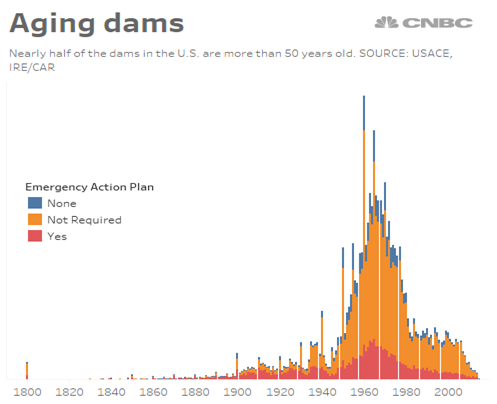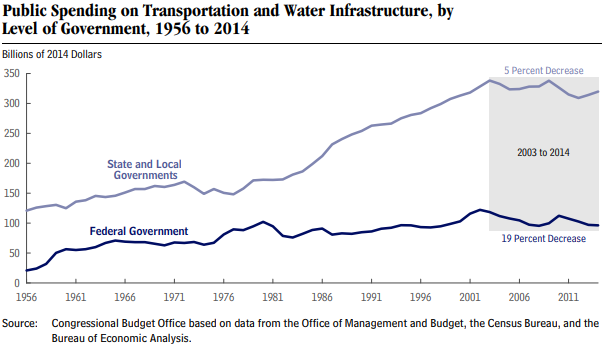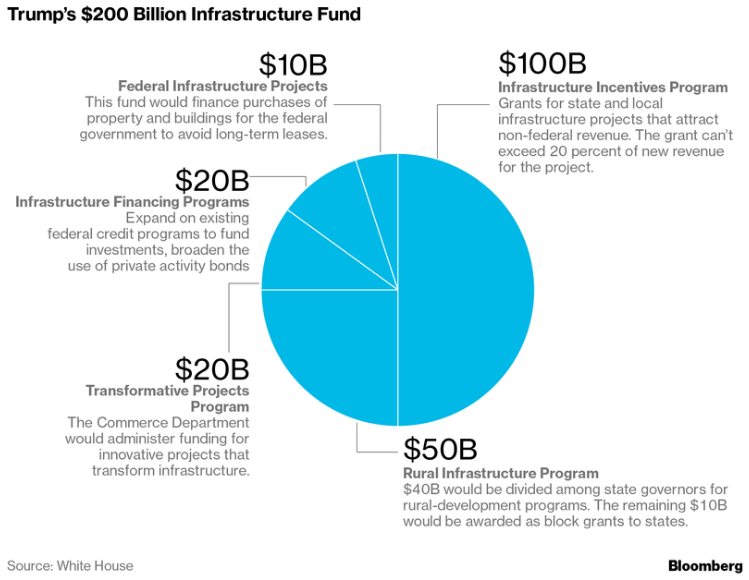The infrastructure of the United States is regarded by many engineers, economists, and policymakers as being in dire shape. From rusting bridges, to highways and streets strewn with potholes, to water systems containing lead, America’s infrastructure needs immediate help. But the problem gets worse when deciding which aspect of America’s infrastructure should be fixed first, the cost to repair it, and who will pay. The key to solving this serious problem is understanding it and knowing what the Trump Administration has proposed.
Current State of America’s Infrastructure
According to the American Society of Civil Engineers (ASCE), the nation’s infrastructure is in poor shape as reflected by the average grade of “D+” that was awarded in its 2017 report. A grade of “D+” states that the condition of America’s infrastructure is “mostly below standard” and shows “significant deterioration” having a “strong risk of failure.” This includes items such as dams, water systems, airports, highways, roads, bridges, and the nation’s electric grid. According to the ASCE the cost to repair, upgrade, and replace America’s sagging infrastructure would come to $3.6 trillion by 2020. The longer the wait to make the necessary repairs, the higher the cost: ASCE states that it will cost $4.59 trillion to fix the nation’s infrastructure if the country waits until 2025. ASCE also stated that the poor state of the nation’s infrastructure costs every American family approximately $3,400 in disposable income annually. In terms of human lives, the information is shocking: from 2014 to 2015 due to the poor condition of America’s roads traffic fatalities went up 7 percent from 2014 to 2015 in which 35,092 people died on the nation’s roads.
Broken down into different categories the nation’s infrastructure situation looks bleak:
Dams: ASCE awarded the country’s dams a grade of “D” and stated that the average age of the 90,580 dams in the United States is 56 years. ASCE also noted that the number of dams regarded as potentially high-hazard has risen to more than an estimated 2,170. For example, in February 2017 almost 200,000 people were evacuated due to damage from heavy rainfall to the drainage channels to the 49-year-old Oroville Dam in California. ASCE has stated that, “the number of dams identified as unsafe is increasing at a faster rate than those being repaired.”

Electric grids: ASCE gave the nation’s entire energy infrastructure a grade of “D+” in its 2017 report and this includes the electric grids servicing the country. The nation’s electric grid has more than 640,000 miles of high-voltage lines that are functioning at full capacity. To make matters worse, many of the nation’s power lines were built in the 1950’s and 1960’s and are regarded as being significantly past their normal usage period. The problem is that it will cost billions to replace these aging power lines in which operators are having a difficult time raising the necessary funds and also deal with frequent power outages which are costing the country’s economy billions in lost productivity. According to Joshua D. Rhodes, a postdoctoral researcher of Energy at the University of Texas at Austin, the cost to replace the nation’s power plants, wires, power cables, transformers and poles would be approximately $5 trillion. Dr. Rhodes has estimated that replacing the nation’s power plants would cost $2.7 trillion.
Water systems: Water is essential to human existence and most everything on the planet depends on it. However, in the United States the water situation is dire. According to estimates by the Federal Environmental Protection Agency (EPA) it will take $632 billion in additional funding to maintain and upgrade the nation’s drinking water, wastewater, and irrigation systems. ASCE has estimated that at least $1 trillion are needed for maintenance and expansion of the nation’s existing pipe system. ASCE has estimated that the nation experiences about 240,000 water main breaks annually resulting in a loss of 2.1 trillion gallons of water per year. Currently the nation’s water system has not seen any signs of improvement: ASCE gave the nation’s drinking water system a grade of “D” in 2013 and 2017. Many engineers feel that the situation in Flint, Michigan in 2014 and 2015 is only the start of a water system crisis that will be seen in other municipalities across the country.

Highways, roads, and bridges: The 2017 ASCE report gave the nation’s bridges a grade of “C+”. And while this may seem like good news compared to the grades given to other infrastructure systems, the bad news is that a grade of “C+” was also given to the nation’s bridges in 2013. In other words, no improvement in four years. ASCE gave a grade of “D” to the country’s roads in 2017 and with good reason: there are massive problems facing the nation’s motorists when then get into their vehicles on a daily basis. For example, ASCE states that more than two out of every five miles of the nation’s city roads face daily traffic congestions and backups that cost the United States $160 billion in wasted time and energy as recently as 2014. The United States is heavily dependent on its automobiles for transportation to work, school and to take a vacation. The nation’s logistic system is heavily dependent upon trucks, large and small, to deliver goods, products, and raw materials to consumers, manufacturers, and retail stores in order to keep the economy moving along. The interstate highway system, first started under President Dwight Eisenhower in the 1950’s, was designed for commercial, military, and private use. However, since that time spending for public infrastructure has dwindled significantly. For example, states have reduced their spending on infrastructure by reducing their budgets 3.8 percent in 2009 and 5.7 percent in 2010 and have not made an effort to make up for lost investments in their roads, highways, and bridges.
The United States needs a massive infusion in funds for improvement to its infrastructure since the benefits would be significant. For example, the Business Roundtable issued a report in September 2016 that an increase in infrastructure spending would have considerable economic benefits to the nation’s economy. According to their report, there would be an increase of $320 billion in economic output by the year 2020 if infrastructure investment went up by 1 percent of Gross Domestic Product (GDP) annually. The report also stated that for every $1 spent on the nation’s infrastructure would see approximately $3 in increased economic activity.
The Trump Administration’s Infrastructure Plan
The Trump Administration, as part of its 2018 fiscal budget, has proposed to include an infrastructure initiative to fix the nation’s bridges, highways, airports, and water systems. This plan also incudes the funding necessary to pay for the repair to the nation’s infrastructure. As stated in the fact sheet provided by the Trump Administration:
. . .the Administration’s goal is to seek long-term reforms on how infrastructure projects are regulated, funded, delivered, and maintained. Providing more Federal funding, on its own, is not the solution to our infrastructure challenges. Rather, we will work to fix underlying incentives, procedures, and policies to spur better infrastructure decisions and outcomes, across a range of sectors.
The Trump Administration will be using key guiding principles in order to determine the necessity and worth of an infrastructure project. Among these principles are:
- Targeted federal investments: Funds for projects must be for the most transformative projects and processes in order to maximize the best use of taxpayer money. The premise is that funds “should be awarded to projects that address problems that are a high priority from the perspective of a region or the Nation, or projects that lead to long-term changes in how infrastructure is designed, built, and maintained.”
- Encourage self-help: While states and municipalities are better aware of their immediate needs that must be addressed regarding infrastructure, they will be encouraged to raise their own funds, take care of their own projects, and that “the Federal Government should support more communities moving toward a model of independence.”
- Align infrastructure investments with entities best suited to provide sustained and efficient investment: The Federal Government will remove itself from certain services and projects that private industry, companies, and organizations could possibly do more efficiently and on a more cost-effective basis. This also includes disposal of underutilized capital assets.
- Leverage the private sector: The private sector will be used more often in order to improve the nation’s infrastructure “through better procurement methods, market discipline, and a long-term focus on maintaining assets.” The emphasis will be on greater public-private partnerships on regional projects.
Among the proposals in the plan are:
- Expansion of the Transportation Infrastructure Finance and Innovation Act (TIFIA) Program that helps the financing of surface transport projects through the utilization of direct loans, loan guarantees, and lines of credit.
- Liberalize tolling policy in which toll roads will be used in order to finance interstate highways.
- Allow private investment in highway rest areas in which private corporations will build, operate, and maintain interstate rest stops.
- Provide incentives for innovative approaches to reduce traffic congestion in cities. Through the Urban Partnership Agreement and the Congestion Reduction Demonstration Programs competitive grants are awarded to cities that are willing to find solutions to traffic congestion that includes congestion pricing, enhanced transit services, increased use of flex scheduling, telecommuting, and increased use of advanced technology.
- Provide funding for the Water Infrastructure Finance and Innovation Act program (WIFIA) in which private investors would commit funds in large drinking water and wastewater infrastructure projects.
- Enhance and streamline the environmental review and permitting process. This would be accomplished by placing the infrastructure permit process as the responsibility of state and local officials when necessary.
The proposed cost of the plan will be $1.5 trillion for repairing and improving the nation’s infrastructure. However, only $200 billion of the proposed funds will come directly from the federal government. The balance of the $1.3 trillion the Trump Administration has proposed will come from state, local, and municipal governments which must match federal spending by a four-to-one ratio. This is part of a long-term trend in which the federal government will assume less of infrastructure spending and pass more of it onto the states and municipalities.
In terms of the $200 billion being parceled out, $100 billion would be given as incentives to local and municipal governments. Then $20 billion would be given to projects that have “national significance” to “lift the American spirit”. The proposal calls for $50 billion for rural block grants so that states can use the funds for rural roads. However, this is based on a formula regarding the number of miles of rural roads and the state’s rural population. These funds can be used for transportation, broadband internet, water systems, wastewater treatment, and electric power projects. The remaining $30 billion would go to such projects and programs as WIFIA.
The Trump Administration is actively pursuing the use of public private partnership (P3) in order to pay for infrastructure projects on the state, local, or municipal levels. The basic premise behind P3 is that government and private sector companies will work together to fund an infrastructure project. The key reasons for P3 is to have governments use private sector expertise on completing public projects and the avoidance of borrowing through issuing bonds or notes to pay for a project. The Trump Administration feels that the private investor funding the project will be reimbursed by either receiving cash flow directly from toll receipts from bridges or highways or user fees on water systems. The other possible way they will be reimbursed is through receiving a portion of tax revenue or fees from the state, local or municipal governments. The assumption is that due to improvement in a state’s infrastructure there will be an eventual increase in its tax revenue and it can then pass the balance on to the private investor funding the project.

Analysis of Trump’s Infrastructure Plan
There are numerous questionable points about the Trump Administration’s infrastructure plan.
The first of these deal with the amount of funding that must be provided by the states as opposed to what the federal government will do. Traditionally, the federal government would take on 80 percent of a project’s cost and the state where the project was to occur would pay the other 20 percent. However, under the $1.3 trillion that the states would have to pay for the infrastructure plan, the Trump Administration has proposed that the federal government will assume 20 percent of a project’s cost as long as the state where the project is the occur will take on the other 80 percent as well as offering financing help for private investors. This new criterion will be used even for a project to be considered for the “incentive” grant money. This will mean that a state must raise funding for an infrastructure project by either increasing state or local taxes, raise its state gasoline tax, impose a toll, or apply a user fee to the project. At this point the federal government will provide funding for the project. This will mean that infrastructure projects that provide some type of cash flow, such as tolls, have a better chance of acquiring funding and perhaps only in wealthier states and municipalities. “There’s going to be many jurisdictions across the country that are desperately in need of infrastructure repair and new infrastructure that have difficulty coming up with the 20 percent match, much less the 80 percent match,” stated the mayor of Austin, Texas, Steve Adler at a United States Conference of Mayors’ meeting in January 2018.
Another questionable point about the Trump Administration’s infrastructure plan deals with the possible rise of the gasoline tax. The federal gasoline tax is currently at 18.4 cents a gallon for unleaded and 24.4 cents a gallon for diesel and has not been increased in 25 years since 1993. In order to pay for the repair and upgrade of the nation’s highways, bridges, mass transit projects, and roads, the funds would need to come from the federal Highway Trust Fund, which due to a shortage of contributions many analysts feel it is now close to bankruptcy. According to the Congressional Budget Office (CBO), unless there are additional funds coming into the Highway Trust Fund in order to pay for the proposed infrastructure projects, the Fund will be insolvent by 2021. If there were an increase to the federal gasoline tax then the cost for the transportation of goods and products will spike and cause a slight jump in inflation. Complicating the situation is that today’s automobiles have greater fuel efficiency along with the increase in the number of electric cars on the nation’s roads, then there may have to be an alternative instituted to the gasoline tax method for paying for repairing roads and highways.
Still another point that raises serious financial concerns deals with the use of public private partnership or P3. Originally proposed by Commerce Secretary Wilbur Ross and economist Dr. Peter Navarro, P3 states that the Administration’s infrastructure would use private investor financial capital while not adding a penny to the federal government’s budget nor its deficit.
The plan’s premise is that private companies would put up front approximately 20 percent of the project costs while borrowing the remaining funds. This could come from issuing bonds or through bank loans. The federal government would give tax credits covering 82 percent of the firm’s investment. In Ross and Navarro’s calculations, the companies only need to attain a 10 percent return on the investment not covered by the tax credits. These tax credits, $137 billion according to some estimates, would ultimately be paid for by the economic activity of the infrastructure projects, the income taxes of the workers on these projects, and the taxes paid by the firms involved in the projects. According to Trump’s “Contract with the American Voter”, his plan “leverages public-private partnerships, and private investments through tax incentives, to spur $1 trillion in infrastructure investment over ten years. It is revenue neutral.”
While theoretically, this seems a great way to pay for massive and expensive infrastructure projects, there are problems. One key difficulty is that P3s have a spotty investment record. P3s are often regarded as a way to transfer financial capital to developers and contractors without guarantees that new investments will be made. The dilemma is creating user fees and often the public partner (government) must provide the guaranteed minimum revenue streams for the project to be built and serve poor communities. The P3 private partner may increase user fees or reduce the quality of service to cut costs and maximize profits hurting users since they may not have an available alternative. The Congressional Budget Office reports that only 14 highway projects were finished using P3s with private financing, while 24 are still under construction, declared bankruptcy, or require financial bailouts.
Ross and Navarro’s plan can work if interest rates stay low. But with the Federal Reserve Bank planning rate increases this year, borrowing costs will rise. The plan can work if infrastructure projects are exclusively built in higher-income and wealthier urban areas. Rural areas with lower-income residents will have difficulties paying for toll roads and user fees. Therefore, builders, developers, contractors, and private investors will decide which projects will go forth and which will not.
While there are other questionable financial concerns with the Trump Administration’s infrastructure plan, a deep concern for states, counties, and municipalities are the cuts to the 2018 Federal budget. The Trump Administration is proposing cutting the “Fast Starts” program which originally allocated $19.5 billion in transit funding for localities in the United States through the year 2028. Due to these cuts, projects in cities such as Seattle, New York, and Los Angeles would be either eliminated or so severely reduced they may not be viable for completion. There are also proposed infrastructure budget cuts to Amtrak ($7.6 billion), the United States Army Corps of Engineers and their projects ($14 billion), the Federal Aviation Administration ($4.5 billion), rural water and wastewater projects ($5.1 billion), and from the Commerce Department’s Economic Development Authority ($2.5 billion). According to the Center for American Progress (CAP), the total amount of budget cuts affecting infrastructure programs and revenue sources in the next decade until 2028 amounts to $275.7 billion. While the Trump Administration wants to repair, improve, and upgrade the nation’s infrastructure, it has seriously removed needed funding and made the task faced by states, counties, municipalities, and local governments that much tougher in the long and short run.
WANTED: A Viable Solution
The problem with the Trump Administration’s infrastructure plan is that it wants to improve and upgrade the nation’s roads, highways, bridges, and airports, but does not want to pay the huge price tag for such an operation. The problem is that the Administration is saying one thing (“Let’s fix it”) but advocating something else (“Let the states and municipalities pay for it”). The problem with the country’s infrastructure is that it will take a great deal of time and money to fix, but the Trump Administration is not offering viable solutions that everyone can agree upon. Unless something is done soon, the problem with the nation’s infrastructure will only get worse and end up costing substantially more in the years to come.
 Arthur Guarino is an assistant professor in the Finance and Economics Department at Rutgers University Business School teaching courses in financial institutions and markets, corporate finance, investments, and financial statement analysis. The first half of his career was spent in the financial services industry working for corporations such as TIAA-CREF, Met Life, and The Bank of New York. He writes articles dealing with finance, economics, and public policy.
Arthur Guarino is an assistant professor in the Finance and Economics Department at Rutgers University Business School teaching courses in financial institutions and markets, corporate finance, investments, and financial statement analysis. The first half of his career was spent in the financial services industry working for corporations such as TIAA-CREF, Met Life, and The Bank of New York. He writes articles dealing with finance, economics, and public policy.
Sample Report
5-year economic forecasts on 30+ economic indicators for 127 countries & 33 commodities.